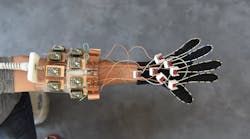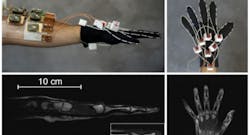Magnetic resonance imaging (MRI) has existed since the 1970s, providing doctors with a tool for looking inside the human body at tissues, bones, torn ligaments, and tumors. MRIs record images by immersing tissues in a magnetic field. Once the tissue has been exposed to the magnetic field, any hydrogen atoms present align to create a magnetic force in one direction in each tissue slice. The atoms are then shifted out of equilibrium by waves of electromagnetic force. Afterwards, the atoms spin like tops and emit radio signals, indicating their location, before being rebuilt into images.
However, MRIs still have limitations recording moving joints. When capturing the image, MRIs also convert radio waves into a detectable electric current via the radiofrequency coils. This creates a problem as the captured radio waves produce small currents inside the receiver coils, creating their own magnetic fields and prevent nearby coils from capturing clean signals.
Since its inception, the last 30 years have tried to manage these interactions between neighboring coils. The state-of-the-art scanners have receiver coils that are carefully arranged to cancel out magnetic fields in neighboring coils. Once the arrangement is set, coils are fixed and no longer move relative to one another. This constrains the MRI image and its ability to capture complex-moving joints.
The image above compares different MRI coil configurations and the accuracy of their MRI scans. The new high impedance coil design of the MRI glove provides a more accurate and clearer picture.
To solve this problem, a research team from New York University School of Medicine created a new device that for the first time can capture images of bones, tendons, and ligaments moving together. The design was featured in a paper published in Nature Biomedical Engineering. The device is a glove that houses MRI detectors that can capture high-quality images of moving joints.
“Our results represent the first demonstration of an MRI technology that is both flexible and sensitive enough to capture the complexity of soft-tissue mechanics in the hand,” says lead author Bei Zhang, Ph.D., a research scientist at the Center for Advanced Imaging Innovation and Research (CAI2R) within the Department of Radiology at NYU Langone Health.
The solution was to design a high-impedance structure that blocks current. All current MRI scanners measure signals that create currents in receiver coils (aka the detectors). These coils have a low-impedance design that lets the current flow easily. By switching to a high-impedance design, the structure can measure how had the force in the magnetic waves pushes the voltage is it tries to establish a current in the coil.
The glove can be used to capture images in motion as well as those rich in water such as muscles, nerves, and cartilage. Tendons and ligaments, which are rich in protein, appear as black bands that run along the bone structure.
Since the MRI signal now creates no electric current, the new receiver coils no longer generate a magnetic field that interferes with its neighboring receivers. This removes the need to have the rigid coil structures found in modern MRI scanners. With the coils free to move and stitched into the glove, images of free moving muscles and tendons can be captured. Since the MRI signal is produced by the hydrogen atoms, the new technique excels in imaging soft tissue rich in water, creating very clear images of muscles, nerves, and even cartilage. Typically, invasive procedures would have been required to study these areas.
Tendons and ligaments remain difficult to see, since they are made of dense proteins instead of fluid (appearing as black bands that run alongside the bone). The study revealed that as fingers flexed, the new coils reveal how the black bands move in conjunction with the bones, which will be useful in cataloging different injuries.
According to senior author Martijn Cloos, Ph.D., assistant professor from the CAI2R institute in the Department of Radiology at NYU Langone Health, “We hope that this result ushers in a new era of MRI design, perhaps including flexible sleeve arrays around injured knees, or comfy beanies to study the developing brains of newborns.”



